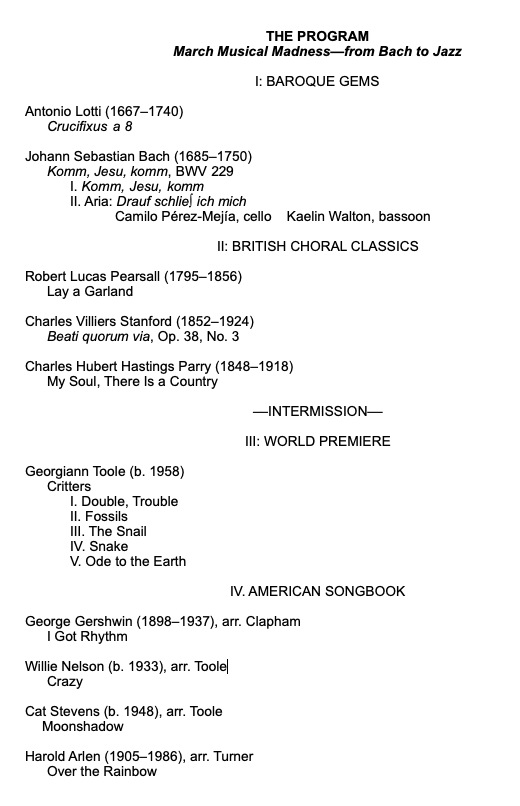March Musical Madness – March 25, 2023

PROGRAM NOTES
We open our program with a nod to the liturgical season of Lent. Venetian Baroque composer Antonio Lotti’s setting of the Crucifixus text utilizes thick eight-part choral writing, chromaticism, and suspensions depicting the death of Christ. Johann Sebastian Bach was aware of Lotti’s work, and the Venetian writing for multi-part choirs influenced his own writing. Despite composing over 300 liturgical cantatas, Bach wrote only a handful of motets; although motets were a regular part of the 18th century Lutheran church service, Bach frequently prepared and presented works by other composers. The details surrounding the composition of his Komm, Jesu, komm are unknown, but it was most assuredly composed for a funeral. Like the Lotti, the texture of the choir is in eight parts, but here it is separated into two choirs, with significant antiphonal writing.
The British choral tradition is central to the history of choral repertoire. The rich heritage can be traced back to Elizabethan composers such as William Byrd and Thomas Tallis. Tonight, we explore three of the greatest hits of the repertory from the 19th and early 20th centuries from very different composers. Robert Lucas Pearsall’s profession was that of a barrister—composition was merely an avocation. His Lay a Garland is a jewel of part writing, not unlike the Lotti in its use of eight-part choral writing and suspensions, and funeral imagery. Anglo-Irish composer Charles Villers Stanford was an academic composer of the highest regard, and his Beati quorum via is a study in construction and Romantic sonority. Charles Hubert Hastings Parry was a rival of Stanford’s and both are largely responsible for the 19th century British choral renaissance. Parry’s “My Soul There is a Country” is the first movement of his Songs of Farewell, written in 1916 near the end of his life.
With Critters, Viva soprano and Shepherdstown resident Georgiann Toole set out to write music about the animals “no one ever sings about”. With references to newt, frog, lizard, snake, and snail these inventive new works are an important addition to the repertoire and we are pleased to be making their world premiere performance!
The basic vocabulary of the jazz world is the “standard” song, also referred to as the American musical songbook. In our final set we pose the question, “When and how does a song become a part of this songbook?” No one would dispute the place of Gershwin’s “I Got Rhythm” and Harold Arlen’s “Over the Rainbow” in that category. We suggest that more contemporary classics such as “Crazy,” made famous by Winchester’s own Patsy Cline, and “Moonshadow,” by Yusef Islam (formerly Cat Stevens), deserve consideration for entry into the canon.
Program notes by W. Bryce Hayes



